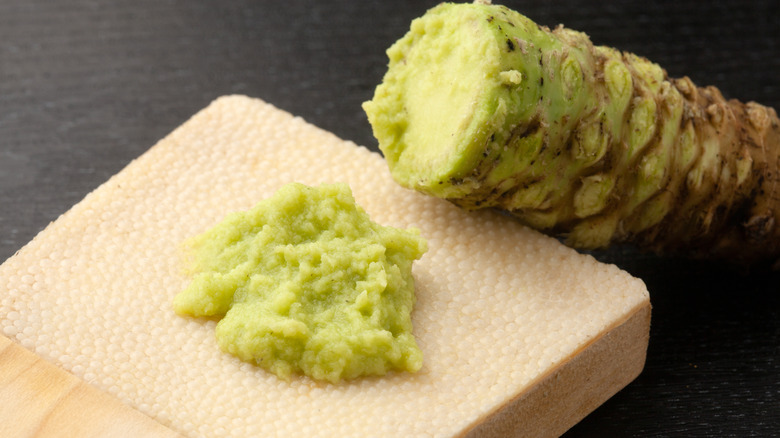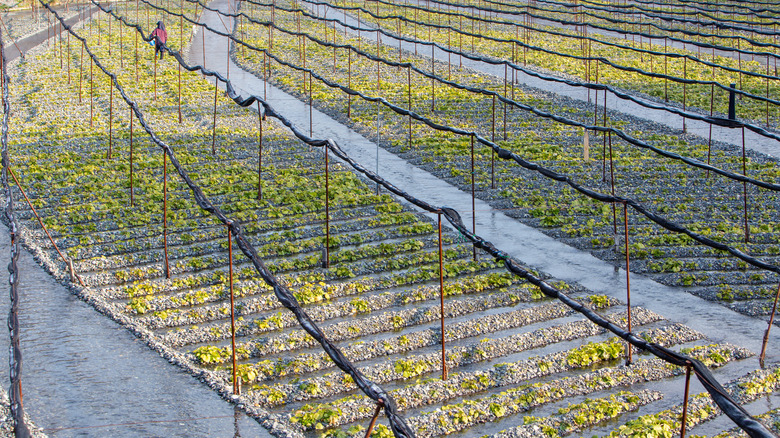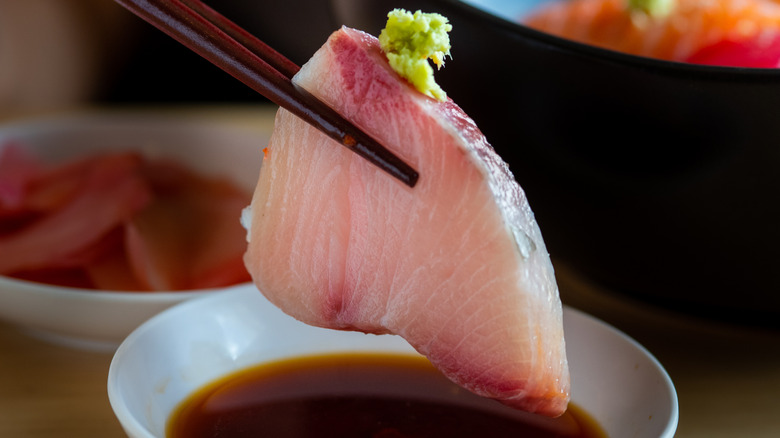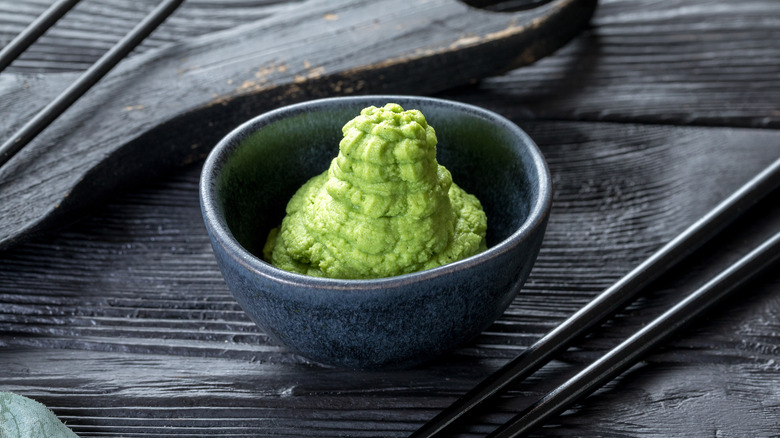Wasabi Production Could Be Entering A Crisis Phase. Here's Why
The Japanese have eaten wasabi for centuries. A non-negotiable component of the sushi or sashimi experience, wasabi is a mainstay that offers a beguiling color and a sharp kick that can clear out your sinuses in one fell swoop. In many instances, though, the wasabi served alongside your shrimp tempura roll may be an imitation product not derived by the actual wasabi plant, which is somewhat similar to horseradish. Wasabi comes from the brassicaceae family, along with horseradish, mustard, and radish. Wasabi is also an incredibly challenging plant to grow, and various modern complications have made proper cultivation more difficult than ever.
Fine Dining Lovers notes that wasabi requires an incredibly particular growing climate. Japanese Food Guide notes that wasabi is especially "finicky" and "requires a constant source of very clean water." Wasabi is also incredibly sensitive to directly sunlight. It can even take up to 3 years for a wasabi crop to fully mature. Clearly, growing wasabi is a time-consuming, very involved process — but it can be so incredibly lucrative. Once harvested, fresh wasabi also has a very short shelf life. It's clearly not the most forgiving plant — and it's a ton of work for a product that isn't ever really consumed on its own volition.
Recently, The New York Times reported that a shortage may be on the horizon before we know it.
What is making wasabi production so difficult?
The New York Times states that rising temperatures in Japan have damaged wasabi crops in recent years, making them "more susceptible to mold and rot." In addition, there the challenges of intense rains, reduced quality water, and wild animals feeding on the crops. The New York Times notes that "these hazards have chipped away at the centuries-old culture of wasabi in the area and imperiled the future" of the incredibly important crop. The Ministry of Agriculture, Forestry and Fisheries notes that the "volume of wasabi produced in Shizuka has declined by close to 55 percent."
The difficulties of growing wasabi have been understood for years. BBC notes that most wasabi farms in North America have "almost all ... failed," again attributing the difficult of properly farming the in-demand root. BBC even states that wasabi is known to be "the most difficult plant in the world to grow commercially" — which also makes it incredibly lucrative. Another aspect that makes wasabi so tricky to grow is because it tends to grow in water beds — it's not fully submerged, but it needs to be watered almost constantly. Furthermore, the process of purchasing (or finding) wasabi seeds is almost very challenging, especially outside of Japan. BBC also notes that when fresh wasabi is used, it should be grated just prior to being eaten, because the flavor actually dissipates after 15 minutes of being grated.
Real vs. fake wasabi
BBC states that Japanese people have used wasabi for centuries to prevent illness. One thought is that it was initially added to sushi and raw fish in order "to prevent food poisoning, not because of its spicy taste."
While high-quality Japanese restaurants grate wasabi fresh, most sushi bars op for a type of "imitation" wasabi paste. Fine Dining Lovers notes that notes that the wasabi you're accustomed to seeing alongside your sushi is traditionally horseradish, mustard powder, and either green food coloring or spinach extract. Furthermore, 95% (!) of wasabi paste is said to be artificial, according to Fine Dining Lovers — even in sushi bars in Japan.
Interested in how to tell the difference? Taste of Home notes that real wasabi tends to have a "grated, gritty" consistency, whereas artificial wasabi tends to be overly smooth and pureed. Taste of Home notes that the sharp pungency of wasabi comes from allyl isothiocyanate, which is processed in a different way than the capsaicin in spicy peppers. Of course, here can be an intense burning sensation if too much is consumed at once.
The future of wasabi
Hiroyuki Mochuziuk, the president of a 147 year old wasabi company, tells The New York Times that "in order to protect Japanese food culture ... it is important to protect wasabi," noting that he feels the current state of wasabi growing is a "crisis." Adding to the problem, the quality of spring water has also deteriorated. For a plant already challenging enough to grow properly, these new issues make the process nearly impossible. In many instances, wasabi won't grow to full maturity and will then be rendered obsolete for selling.
While the Japanese government has attempted to crossbreed and utilize wasabi seed varieties in different manners, no "perfect solution" has been developed as of yet. The New York Times also notes that so many wasabi farmers are centuries-old family businesses, and that the children who would be expected to take on the family business are now opting for other futures and careers instead.
For all of the wasabi farmers and sushi fanatics, we hope that wasabi production is able to be stabilized as best as possible again in the near future.



